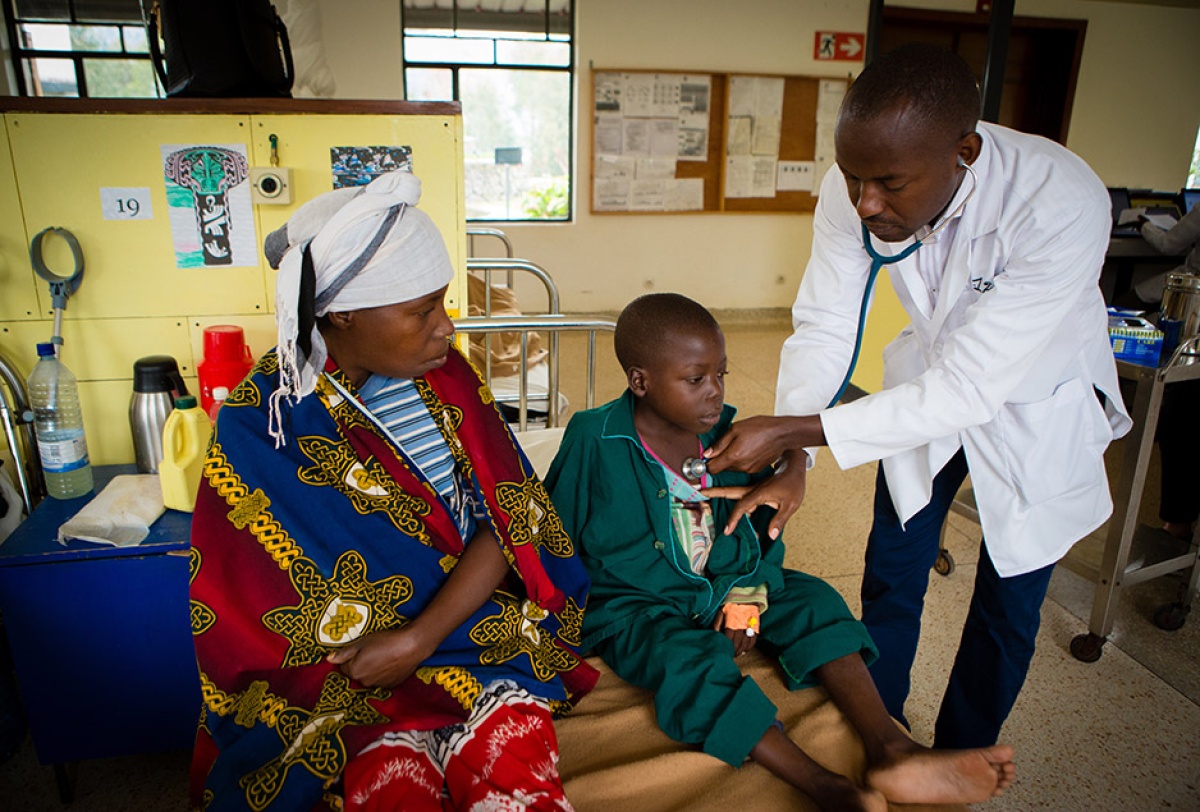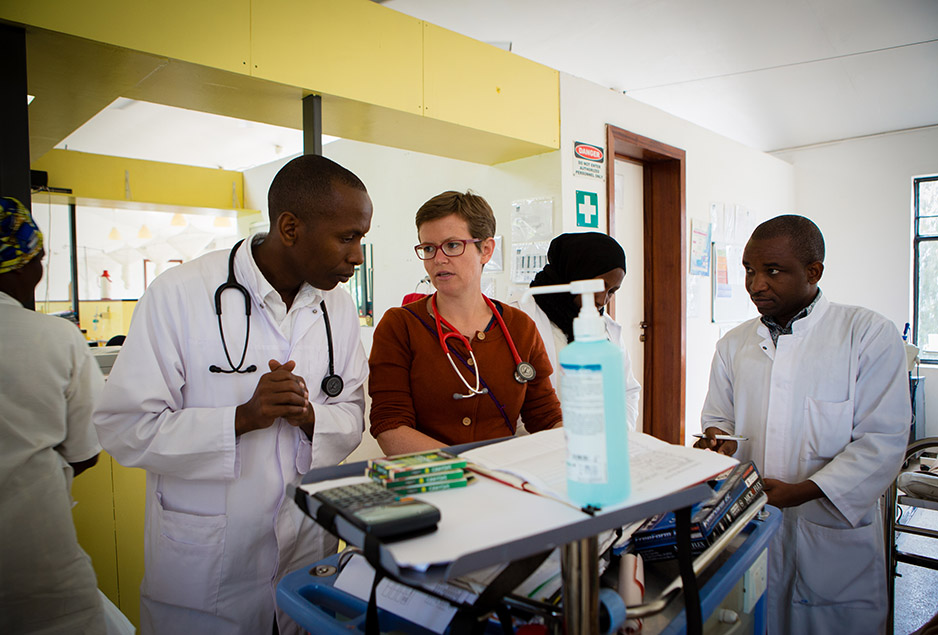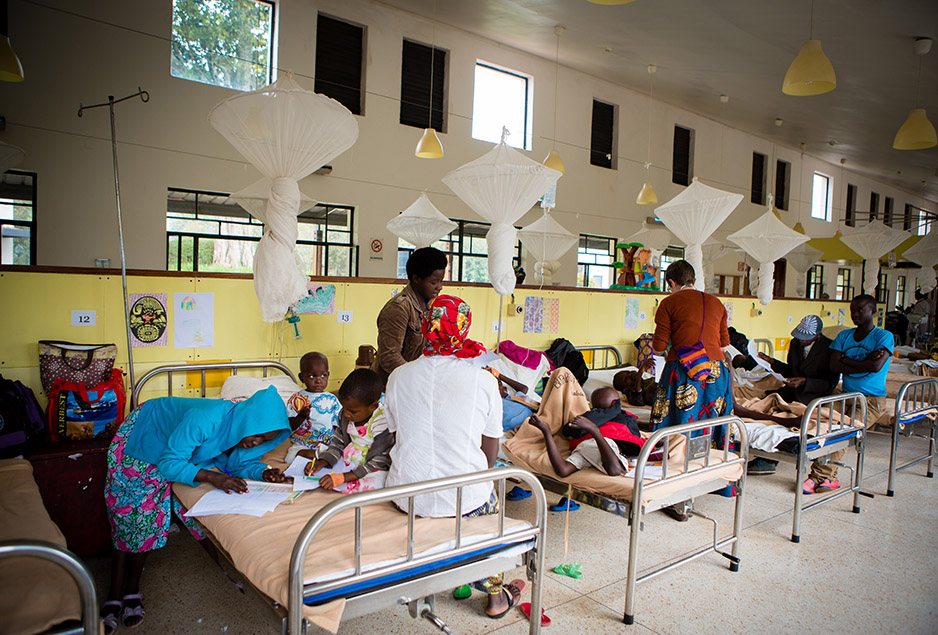Doctors See Daily Success at Butaro Cancer Center
Posted on Sep 18, 2017

Five years after opening, the Butaro Cancer Center of Excellence is achieving extraordinary successes in rural northern Rwanda, amid daunting challenges.
Doctors at the Partners In Health-supported facility are treating about 1,700 patients every year, young and old, on the campus of the public Butaro District Hospital. The campus lies amid lush, green hills in a remote region not far from the Ugandan border. Many patients, family members, and caregivers travel to Butaro from across Rwanda or from surrounding countries such as Burundi and the Democratic Republic of Congo, where high-quality cancer care is scarce or nonexistent.
Antoinette Habinshuti is deputy executive director of Inshuti Mu Buzima, as PIH is known in Rwanda. She said the care provided at Butaro is incredible, especially given the cancer center’s location and limited resources.
“This is a place where you wouldn’t easily find a pediatric ward for cancer patients,” she said.
Some of Butaro’s greatest successes can be found in its youngest visitors—children who come to the cancer center with slim hopes buoyed by fighting spirits, often with cancer that is in late stages because of treatment delays or misdiagnoses elsewhere.
In recognition of Childhood Cancer Awareness Month, which continues through September, we spoke with Dr. Cyprien Shyirambere, Dr. Grace E. Dugan, and other current or former members of Butaro’s pediatric oncology team. With optimism and energy known only to doctors who see positive steps toward recovery happen daily, they described what it takes, and what is needed, to treat the hundreds of children who have come to the cancer center since it opened in 2012.
“A normal day in the pediatric oncology ward at Butaro would have about 15 patients to see,” said Shyirambere, associate director of the oncology program and one of the center’s two pediatricians, along with Dr. Alexis Manirakiza. “Among them are 10 who need chemotherapy and maybe four other patients who were admitted because they are sick, very sick and on oxygen.”
Shyirambere said his day usually starts around 7 a.m., making rounds through the ward to see if any children have immediate needs. If all is well, he’ll start preparing chemotherapy regimens for the day. That process can take several hours, Shyirambere said, adding that the crafting of chemo regimens is part of an ongoing collaboration with Dana-Farber Cancer Institute in Boston.
Shyirambere’s afternoons at Butaro can include administering chemo, conducting bone marrow biopsies for new patients, and, of course, just spending time with the children he’s treating.
“It’s a busy day for a doctor and a few nurses,” he said.
Patients in the pediatric ward last spring included Frank Mugisha, 6. In March, Frank completed 30 months of treatment for acute lymphoblastic leukemia, and was shown in PIH photos smiling in a doorway and spending time at Butaro with his aunt. Butaro staff will continue monitoring him for the next five years.

Dugan, who’s been a clinical officer in Butaro’s pediatric cancer ward for about a year, said relapse is a constant concern.
“It takes a long period of follow-up to be sure you’ve really cured someone,” she said.
Also in Butaro last March was Blandine Umurisa, 12, who was completing more than two years of treatment for acute lymphoblastic leukemia. Her treatment had included three rounds of chemotherapy. PIH photos of Blandine show her working on math homework a day after chemo, and walking through the ward with her arm around Shyirambere’s waist, and his arm over her shoulder. Although she had finished her cancer treatment, doctors diagnosed Blandine with pulmonary tuberculosis in November 2016. Her treatment for TB was ongoing last spring.
Dugan said Blandine was from the Democratic Republic of Congo, and living in a refugee camp in Rwanda. Blandine visited Butaro for a routine follow-up Sept. 18, Dugan added, and her cancer still was in remission.
The names of both children have been changed for privacy.
Their stories are among hundreds.
The 20 or so beds in the cancer center’s pediatric ward are nearly always full, because of rapidly rising demands for cancer care and the hospital’s already high-volume general pediatric ward.
Dugan spoke frankly about the challenges of operating the only full-service cancer care facility within hundreds of miles.
“There are times when every second bed has two kids in it,” she said.
Monitoring all of those patients around the clock requires staffing levels that the cancer center doesn’t always have.
In an August conference call from Butaro, Shyirambere quickly cited a desire for an “adequate number of nurses,” when asked his greatest need. But he also was quick to praise the nurses he has on his team.
“They work extra hours, to make sure every child with cancer receives care before they go home,” often working well into the evening, he said. “I really appreciate the hard work of our nurses.”
Habinshuti, IMB’s deputy executive director, said increasing recognition of the work at Butaro—and increasing numbers of people seeking care—can create difficult decisions for doctors.
“I think the challenge we have now is being victims of our own success,” she said. “Cancer treatment requires a lot of resources, but it’s going well so far.”

A shortage of health care workers is a global problem, and particularly severe in Africa and southeastern Asia. A 2015 report by the World Health Organization estimated a global shortage of 17.4 million health care workers, including nearly 2.6 million doctors and more than 9 million nurses and midwives. The document estimated there were 43 million active global health workers worldwide in 2015.
Butaro’s staff often is boosted with support from Dana-Farber and PIH.
Jen Haley, for example, is a former Dana-Farber cancer nurse who worked at Butaro as an oncology nurse educator from September to December 2016, through a PIH program.
Haley said she helped nurses at Butaro learn to watch for symptoms at various treatment levels, improve the overall quality of treatment, and educate patients’ families and caregivers about cancer and related care.
Haley said she also stressed “the importance of letting them be kids,” amid the rigors of extended treatment. She and Dugan hosted Movie Fridays, for example, showing children’s movies on laptops—Haley said “Madagascar” was a favorite. Young patients at Butaro also were fans of pop music, Haley added, and liked to grab her smartphone to sing and dance along.
“I think that was where I kind of got my mental health from, just going in and playing music with the kids,” Haley said. “Kids are so resilient. One minute you’re giving them a shot and the next minute they’re running up and giving you a hug.”
Butaro’s staff has to be equally resilient, amid limited resources.
They don’t have a CAT scanner, an intensive care unit, or enough nurses. Stocks sometimes run out of needed medicines, and radiotherapy machines are a distant hope.
Dugan said working at Butaro has showed her that those things should be staples, not wished-for items.
“Cancer treatment is not a luxury. This is not an optional extra for a health system in a poor country. It’s very much at the core of what should be provided,” she said in August, days before returning to Rwanda after a visit to the U.S.
Shyirambere said he draws strength from successes. Treating children with cancer can be incredibly emotional, he said, but the reward is seeing young patients come back for positive follow-ups, return to school, and resume healthy childhoods.
“You feel like your day has been excellent,” he said.
Check out this photo gallery to see more images from Butaro's pediatric cancer ward.

